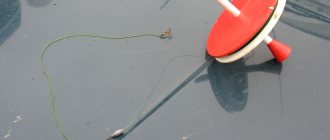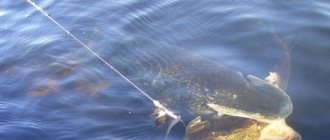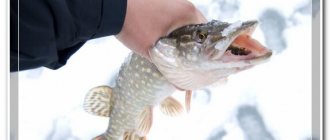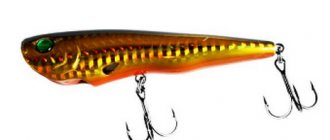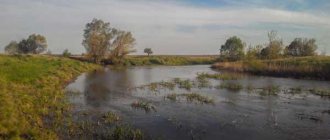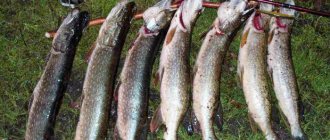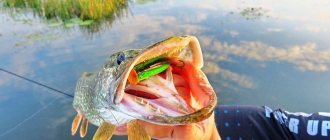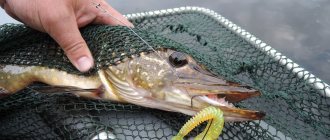Late spring, summer, early autumn - at this time small bodies of water, the banks of rivers, lakes and reservoirs are covered with a thick carpet of green vegetation. The grass pike lives in reservoirs with green reeds, with an abundance of algae and duckweed, water lily leaves - the diversity of freshwater flora significantly complicates fishing for pike with a spinning rod. How to find a predator in “grass thickets” - an overview of all the nuances of fishing in overgrown waters.
Features of pike fishing in overgrown reservoirs
Such reservoirs are also called “toad ponds”. These are mainly small water areas (ponds, stakes, bays), which are abundantly overgrown in consistently warm/hot weather. Pike fishing in the grass is possible from May to September: the exact timing depends on the specific region.
Reference! A flat bank or a shallow overgrown with grass are areas that should be avoided. Even the smallest grass pikes do not live here. The required depth of the reservoir for successful fishing is at least 1 m.
Promising places for pike fishing in overgrown waters.
- The thickets of reeds at the confluence of the channels are a “Klondike” for the fisherman.
- Entrance/exit to the pit, overgrown with grass. Here pike often ambush small fish.
- Grassy islands on a deep channel - predators here either wait for small fish or hunt frogs.
- Snags and places where plant debris accumulates.
- “Windows” in thickets of reeds and duckweed.
- The reed-open water boundary.
In such reservoirs it is preferable to fish from a boat. Using a watercraft, you can quickly find a suitable area, approach it quietly and carry out high-quality wiring.
Lures
Lures for catching grass pike include:
- spinners (spinning and oscillating);
- wobblers (all types, shapes and sizes);
- jig rubber (more precisely silicone);
- foam rubber.
Spoons perform well in open areas of reservoirs. Fishing with this bait is effective when it is necessary to lure pike from grass thickets to an area of open water. Winter spinners and balancers are the best baits for catching pike in winter.
Wobblers, especially floating models, are indispensable when you need to look for grass pike in windows among aquatic vegetation or look for a predator in the upper layers, among coastal grass. Wobblers with a “pike” silhouette and color are also capable of provoking a pike attack, because this fish does not like intrusions from competitors.
Silicone jig baits (twisters, vibrotails, worms) have no equal in cases where it is necessary to search for pike in the bottom layers.
Foam fish are one of the most effective baits for catching pike at any time of the year and in any weather.
What to catch grass pike with, what kind of bait to use, you will have to decide directly on the reservoir.
Grass pike
Some fishermen distinguish grass fish as a separate type of pike stock because of their specific qualities. Grass pike prefer to hunt in thickets and are found only in shallow water. These are unpretentious predators whose diet includes waterfowl, fry and small frogs.
Differences from bottom pike
| Parameter | Bottom (deep) | pike Travyanka |
| Habitat | Great depths and large bodies of water. Preferred places are holes, whirlpools, fairways. Rarely found in shallow waters. | Exclusively zones of coastal vegetation. Depth – up to 2-3 m. |
| Hunting | Deep-water zones, flooded shelters (trees, snags). | Ambushes in "grass thickets". |
| Appearance | Thick and long body - “stump pike”. | Long, thin, brightly colored and light in weight. |
| Adult size | The average is from 70 cm in length. | 40 cm long. |
| Weight | Reaches 10-16 kg. Record-breaking predators weigh more than 20-30 kg. | 1.5-5 kg. There are individuals weighing 500 g. |
| Lifestyle | Single. They rarely gather in flocks. | |
About
Varieties of pike
There are many varieties of predator: armored, black, relict, leopard, American and others. Each type has its own characteristics.
Shelled pike
The armored pike or gaspar is quite large in size - from 88 cm to 2 m or more (some individuals can reach 3 m). It has a longer snout and small pear-shaped gill rakers. Lives in water bodies of North and Central America. Known species include spotted shellfish, Florida, blunt-nosed and long-snout shellfish.
The fish got its name because of its hard shell in the form of diamond-shaped scales. Inside the first layer there is a bone base, and outside there is a layer of ganoin, a kind of enamel.
It can be caught well with natural bait all year round, especially in early spring. This species of pike is capable of forming small schools. It feeds mainly on small fish, often sick or weakened.
The color of the predator is greenish-silver with characteristic spots located throughout the body, including the fins and tail.
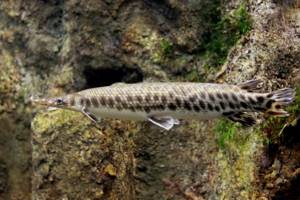
Black
Black pike or Esox niger lives in lakes and rivers of North America. Selects bodies of water with a temperature of 10°-20°C. The fish needs mainly freshwater places with a depth of up to 6 m. It feeds on crustaceans, small fish, snakes and mammals.
Like its Russian relative, the American black pike can be short in length - up to 40 cm. Weight can reach 1.2-4.25 kg. The predator's body is strongly flattened at the rear. The head is large and flattened with a long muzzle and prominent teeth.
There are characteristic stripes on the sides, just like the common pike. Despite its name, the black raptor is predominantly greenish-yellow in color, but has a noticeable dark stripe under each eye.
Feeds on small fish. There are often eyesores because pike are blind. This does not prevent the predator from surviving in the aquatic environment, since it senses the approach of prey by vibrations in the surrounding water.
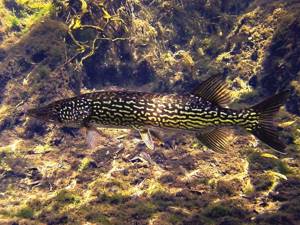
Chukotka, Amur and northern pikes
These species live mainly in fresh waters in the East of Russia (in the Amur basin, Sakhalin, Ussuri, Sungari, Tugur, Uda, Lake Khanka, etc.). The predator has smaller scales than the common pike. Color: silver or greenish, dark back.
There are characteristic black spots on the fins or oblique transverse stripes. Fish can be very heavy - up to 20 kg. But the maximum body length usually does not exceed 1.1 m. Due to its decent weight, pike is often called trophy pike.
Muskinong
Maskinong or Esox masquinongy is the largest species of the pike family. Inhabits the waters of North America, mainly lakes and bays of rivers with weak currents. The length of the masking is about 1.8 m. The weight can reach 32-45 kg. The fish lives up to 30 years and loves a solitary lifestyle.
Females become sexually mature in the fifth year of life and lay from 60 to 100 thousand yellowish sticky eggs with a diameter of about 3 mm. The fish feed on their own kind, including quite large individuals. They fish for musky in early autumn: from September to mid-October.
Ling
This fish is also called baracuda - it is so aggressive. It attacks from ambush, using sharp teeth and a full body strike. It feeds on shrimp, small fish, and squid. Maximum length - 2 m. Can attack a person. It lives in a wide variety of places, including coastal areas of the eastern Atlantic.

It likes to be near the bottom over rocky soils; it does not form large aggregations. It is found at depths from 100 to 1000 m. The body is elongated and the head is long with a chin barbel and a rounded fin.
The back and head are reddish-brown, the sides are somewhat lighter, the belly is yellow to white. The posterior parts of the dorsal, anal and caudal fins are black with a light edge.
It is also edible, like the common pike, so its fishing is carried out by bottom trawls, gill nets and longlines. In the world register of marine species it is listed as Molva molva.
If you are allergic to seafood, it is better not to eat sea pike. But for everyone else, its meat is a storehouse of vitamins and nutrients. In particular, moth contains the entire set of B vitamins, as well as magnesium, calcium and potassium.
Pike tastes like cod meat, but is considered drier. Perfect for any dish, including restaurant delicacies.
Pike with horns
Dragon pike is quite rare. Mainly in the rivers of Siberia. It differs from other fish in having horns on its head and harder scales. Weight can reach 7−14 kg or more. It is extremely difficult to find such a fish.
Relic pike
Pike is one of the most ancient fish on earth. The body of the relict inhabitant of the depths, which has survived to this day, is covered not with scales, but with a shell. The length of such a predator can reach 3 m. The weight of the monster is up to 150 kg.
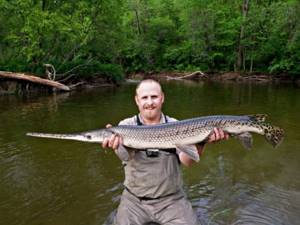
The relict predator can be found in water bodies of North and Central America. It also loves subtropical rivers and lakes with water temperatures of +10...+20 °C. The life expectancy of such ancient representatives of the pike genus is from 18 to 36 years.
Travyanka
The grass pike lives close to the shore in coastal vegetation. Weighs up to 2−10 kg. Feeds on fry and insects. Least active during hot periods. In appearance it is similar to an ordinary pike, but greener and thinner.
Grassfish are actively caught from mid-May to the end of August. For fishing, they look not for shallow water, but for thickets of grass at a depth of 1 to 1.5 m, or even 2-3 m. Grass can be found next to grass islands in a deep channel, in reed thickets at the confluence of channels.
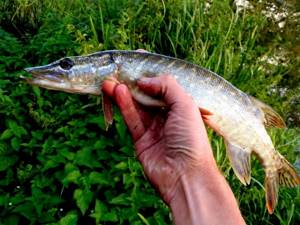
mullet
The mullet-shaped pike is a marine species. It can reach a length of up to 3 m, but usually its dimensions do not exceed 1 m. Young specimens like to stick to lagoons or shallows, while adults, exceeding 8-10 kg, are often found in the open sea. The mullet-shaped fish lives in tropical and subtropical seas.
The predator is distinguished by a powerful and well-developed, fairly large lower jaw. Sea fish are as dangerous a predator as the common pike. Its body is covered with very small and rather dense silver-colored scales with stripes on the sides.
The fish can reach speeds of up to 42-43 km/h. It feeds on anchovies, mullet, horse mackerel, squid, crustaceans and shrimp.
Deep
Deep fish are heavy (at least 7-14 kg). They live at different depths, including about 8-10 m. They love places with a slight current, large snags, logs, and deep-sea stones. It is best to fish from a boat.
Landing such a large fish can take at least half an hour. Predators live alone in their holes.
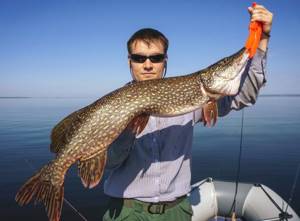
African pike
African pike, Kafue pike (Hepsetus odoe) measuring no more than 70 cm and weighing up to 4 kg. The fish has a greenish-olive color with silver sparkles and a dark honeycomb pattern on its raised scales. The tail is two-lobed with a deep notch.
The predator loves quiet creeks and floodplains. It feeds mainly on small fish. Lives in the Congo and other African rivers.
Leopard print
Leopard pike is quite rare. Basically, this unusual color is found in the Amur predator. It can reach more than a meter, with a very large weight (up to 20 kg). The scales are small and silvery.
The spots are black-brown, randomly scattered throughout the body, starting from the head and ending with the tail.
American
Esox americanus or American pike is a species of predator that lives in the Mississippi River and other bodies of water in the Gulf of Mexico. Due to the characteristic color of its fins, it is often called the redfin. Loves dammed areas of rivers with heavily developed vegetation.
Externally, it is distinguished by a shorter snout and small size (up to 40 cm). There is also a subspecies of American pike - southern grass. They do not gain more than a kilogram of weight and are small in size. The fins are not orange.
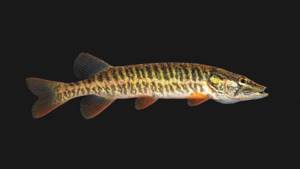
Mississippi girt
Atractosteus spatula or alligator gar is one of the large fish species in the United States. It is found mainly in fresh water, but is also found in salt water bodies and salt marshes. The teeth are needle-shaped, the mouth is large.
The length of the carapace can reach 3 m and weigh over 130 kg. It is believed that the carapace appeared on the planet more than 100 million years ago during the Mesozoic era. The caviar of this fish is poisonous, and the meat of the shellfish is eaten extremely rarely.
Spinning rod for pike fishing in the thickets
The abundance of grass on the surface of the reservoir makes significant adjustments to all stages of the fishing process. The first is a spinning rod. For fishing in thickets, a light or ultra-light, short (2-2.5 m) is suitable. The action is fast or ultra-fast, heavy test - 30-50 g. A rod with the appropriate parameters will easily drag the bait along with the catch and grass through stems, leaves, algae, and snags.
Reel requirements:
- the system is inertialess;
- enlarged drive gears;
- instant stopper;
- Line laying is uniform.
For fishing in overgrown reservoirs, you can even take multiplier reels, popularly known as “winches”. They pull fish perfectly even through dense thickets.
Instead of monofilament line, it is better to use braided cord. In dense vegetation, its color/brightness/visibility are not important criteria. It is recommended to use a thick cord with a breaking load of 15 kg. It will not stretch, so hooking a predator will be reliable at any distance from the shore.
Attention! We must not forget about metal leashes from 20 cm. It is better to forget about swivels and large carabiners, as they will constantly collect tufts of wet grass.
What gear to use
In winter, this fish is caught well:
- for the winter version of the girder;
- for winter float gear.
In both the first and second cases, the best bait will be live bait.
The fishing rod must be equipped with a reel. The length of the fishing rod should not exceed 75 cm. The reel can be inertial or non-inertial. Winter spinning reels are, of course, more reliable and are equipped with a friction brake, but in severe frost conditions they can fail.
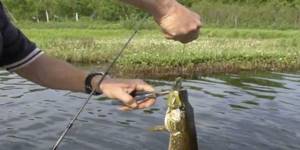
The main line can be monofilament or made from high-quality braid. The cross-section of the monofilament main line is at least 0.2 mm. When fishing for pike, a metal leash with a length of 20 cm is required.
During the period of open water, grass pike can be caught:
- on the summer vent;
- on mugs;
- on a live bait float rod;
- on artificial baits using a spinning rod.
The most effective way to catch grass pike is considered to be fishing with an Ultra-light class spinning rod with a weight of 2 to 8 grams.
To increase its sensitivity, such a spinning rod should be equipped with a spinning reel with a front friction brake.
The spinning rod equipment should include a monofilament line with a cross-section of 0.2 mm or braided line (if you have to fish in a heavily overgrown reservoir) with a cross-section of 0.15 mm. It is mandatory to use a metal leash with a length of 10 cm or more.
How to catch pike in the grass with a spinning rod
An important skill is the ability to accurately cast the bait, since incorrect movements lead to the collection of excess vegetation. For the same reason, long casts are not recommended in reeds and grass. Better results can be achieved by using bait to imitate the natural behavior of small fish, the predator’s main food.
Techniques and tactics of fishing and retrieving
The types of wiring differ for different baits. For unshipped rubber, this is uniform, jerky or stepped wiring. You need to try all types of animation on a pond to determine the best one. Useful advice - when the bait hits the “window”, stop the wiring and let it fall to the bottom, then begin to reel in the line.
Reference! To revive the bait and attract pike, perform uniform twitches and swings of the rod. They also tap the form with their free hand, keeping the line taut.
The spinnerbait is led evenly or in waves. For walkers, poppers and crawlers, jerk wiring is preferred. The jerk is performed with a rod, then the slack in the fishing line is reeled in, then a second swing is made with the spinning rod. With this wiring, walkers “scour” from side to side, poppers and crawlers capture water from the surface, throw it forward, creating a noise that attracts predators.
Fishing Features
1.Search for a place. For catching the grass subspecies of pike, a river bay, an oxbow lake, a bay in a lake or a reservoir with a depth of 1 to 2.5 meters, densely overgrown with aquatic vegetation, is suitable. It is good if the current in such a place is weak, and the water has a weak additional recharge in the form of springs or streams flowing at this place into the reservoir.
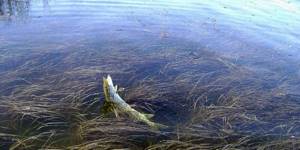
2.Choice of tackle and bait. Unfortunately, practical advice can only be given by fully understanding all the fishing conditions in a given body of water.
3.Wiring method. Under normal conditions, when the pike is sufficiently active, the classic step retrieve remains the best way to use artificial bait. In the case when the grass is passive, the twitching technique is used.
Catching the grass subspecies of pike allows the angler to better experience the behavior of the gear in certain conditions, practice and improve acquired spinning fishing skills. Catching grass pike is the first step in the quest for trophy fish for any novice spinning angler.
Video: Fishing for pike in shallow water in the grass using a spinning rod
Catching pike with a spinning rod in the grass is not an easy, but exciting activity. This type of fishing is possible only in the warm season. The predator is caught in ponds and stakes, the surface of which is abundantly covered with mud, algae, and duckweed. For such fishing, a special rod and bait are selected, and fishing tactics also differ.
Views: 258
Similar articles:
- Catching pike with stickbaits, walkers and poppers Many anglers are accustomed to the idea that pike invariably...
- Catching pike with a wobbler Pike is a voracious river predator, which can be fished all year round...
- Trolling pike. TOP 10 best wobblers for trolling for pike Pike, especially large ones, most often stay at depth, and to catch…
- Pike biting calendar Pike is a smart and cunning predator that you can catch...
Maximum weight and size of pike
In nature you can find pike of completely different sizes. There are both very small species and incredibly large ones.
How to determine the weight of a pike by length
The weight of a pike can be determined by eye, without weighing it, but focusing on its approximate length. A fish 80 cm long usually reaches a weight of 5 kg, 84 cm - 6.2 kg, 87 cm - 6.9 kg, 90 cm - 8 kg.
The fish is measured from the beginning of the snout to the end of the scales. Smaller fish are defined as follows: 25 cm - 0.1 kg, 35 cm - 0.3 kg, 54 - 1 kg, 66 cm - 1.4 kg.
Minimum size allowed for catch
Pike in the Russian Federation can be caught with a size of 35 cm. The same requirements are established in Belarus and Ukraine.
How many times is pond pike lighter than Black Sea pike?
Pond pike weighs 10 times less than larger sea fish. For example, if the Black Sea variety can weigh about 25 kg, then the pond inhabitant is only 2.5 kg.
The largest caught pike in the world
It is believed that the weight of the largest common pike in the world is 25-28.35 kg. But in the Irish Lough in the 19th century, a pike weighing more than forty kilograms was caught.
Are there albino pikes?
White pike are extremely rare. They are mostly gray-green and dark in color.
Pike fishing seasons
Every fisherman knows that pike is a solitary fish, that it loves bodies of water with weak currents, stays close to vegetation, loves holes and snags.
Young pike actively hunt from the very first days, often their prey is much larger than themselves. By the end of the first year of life, the young reach up to 40 cm and weigh up to 1 kg. In large lakes, up to several dozen pikes up to a meter long and weighing up to 15 kg can be caught in one season.
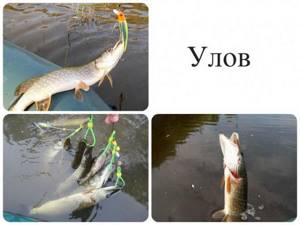
Great catch
The best time to catch pike is in spring and autumn.
After the spring floods have subsided, the pike spawns and after a short rest (called pain), it begins to eat to restore strength. The predator, hungry during the winter, rushes at everything that comes into its field of vision and takes any bait, rarely leaving. In spring, the bite continues throughout the daylight hours. At night the pike sleeps. The most catchy places are shallows and coastal vegetation - there the water warms up faster and the entire “pike menu” actively feeds and warms up there. And fishing is especially successful on warm, cloudy days.
In the fall, sensing the approach of hungry months, the fish begins to stock up on fat. Although in the fall the bite is not so intense, and the pike stays more at depth, where small fish go for the winter.
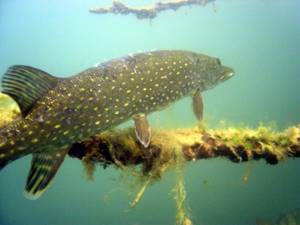
Pike in ambush
But autumn fishing is much more interesting and exciting. Moreover, the pike have eaten well over the summer, are very energetic, and actively resist. And fish meat is much tastier.
But in the summer, pike take extremely inconsistently - sometimes they take, then they don’t take at all without any obvious reasons. And in the summer the predator takes it unreliably and in most cases only clings with the lower lip along the very edge and often gets off the hook. The best time is from noon to 16:00.
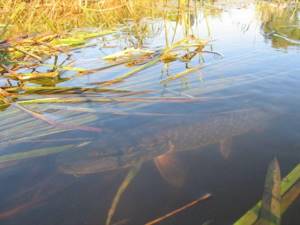
Queen of the pond on vacation
In summer, predators move to the thickets of water lilies, lotus and water chestnut thickets, as this is where all the small fish and duck broods are kept. At this time, literally in the very shallows you can see huge pikes weighing 10-15 kg, warming their sides. If you successfully cast a spoon or wobbler, a snag may occur when it hits the water.
Catching trophy pike
For big fishing, you need to prepare and tune in accordingly. Firstly, large pike are attracted by large bait and the most successful ones today are real silicone monsters up to 25 cm long! The little thing won’t bother you, but a pike weighing 7-8 kg will definitely be interested in why something so tasty appeared there. For such a large bait, the “track” fishing method is best suited. This is when the boat is driven by a motor, and 2-3 baits are pulled behind it at a distance, at a slow speed.
The peculiarity of the pike is that after an unsuccessful hook, it does not hide in the depths and does not swim away, but returns to its parking place.
Therefore, it is necessary to catch potential places where a predator can sit in ambush many times. If the pike misses, nothing happens. We must try again and again to throw closer and closer to her and slowly tease her. The fish will not stand it and will definitely get caught.
But the pike never goes on a long chase, although it may take a risk from ten meters away. There were cases when the fish even jumped out of the water, trying to catch the outgoing bait.
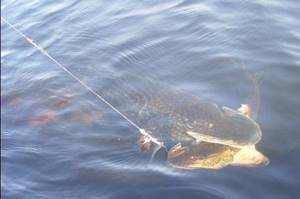
A large pike grabbed a hooked pike
